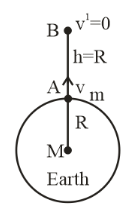
A body attains a height equal to the radius of the earth when projected from earth surface. The velocity of the body with which it was projected is
(A) $\sqrt {\dfrac{{GM}}{R}} $
(B) $\sqrt {\dfrac{{2GM}}{R}} $
(C) $\sqrt {\dfrac{5}{4}\dfrac{{GM}}{R}} $
(D) $\sqrt {\dfrac{{3GM}}{R}} $
Answer
569.1k+ views
Hint:In order to solve this problem, first use the concept that at the maximum height point, the velocity of the body becomes zero. After then use the conservation of energy at points A and B. Where point A is the point of earth surface from which body was projected and point B is the maximum height point from which body comes back to earth.
Complete step by step answer:
Let the velocity of the body with which it was projected be V and radius of earth is R and mass M.

And given that the height attained by the body is equal to R.
We know that at maximum height point the velocity of the body becomes zero.
Now applying conservation of energy at the surface and at a height $h = R$
\[\Rightarrow {(K.E.)_A} + {(P.E.)_A} = {(K.E.)_B} + {(P.E.)_B}\]
$\Rightarrow \dfrac{1}{2}m{v^2} + \left( {\dfrac{{ - GMm}}{R}} \right) = 0 + \left( {\dfrac{{ - GMm}}{{2R}}} \right)$
$\Rightarrow \dfrac{1}{2}m{v^2} - \dfrac{{GMm}}{R} = \dfrac{{ - GMm}}{{2R}}$
$\Rightarrow \dfrac{1}{2}m{v^2} = \dfrac{{ - GMm}}{{2R}} + \dfrac{{GMm}}{R}$
$\Rightarrow \dfrac{1}{2}m{v^2} = \dfrac{{GMm}}{{2R}}$
$\Rightarrow {v^2} = \dfrac{{2GMm}}{{2mR}}$
$\Rightarrow {v^2} = \dfrac{{GM}}{R}$
$\therefore v = \sqrt {\dfrac{{GM}}{R}} $
So, the velocity of the body with which it was projected is $\sqrt {\dfrac{{GM}}{R}} $.
Hence, option A is the correct answer.
Note: In order to solve gravitational or satellite problems 2 methods are used.
1. Energy conservation method.
2. Equate centripetal force with the gravitational force.
i.e., $\dfrac{{m{v^2}}}{R} = \dfrac{{GMm}}{{{R^2}}}$
Complete step by step answer:
Let the velocity of the body with which it was projected be V and radius of earth is R and mass M.

And given that the height attained by the body is equal to R.
We know that at maximum height point the velocity of the body becomes zero.
Now applying conservation of energy at the surface and at a height $h = R$
\[\Rightarrow {(K.E.)_A} + {(P.E.)_A} = {(K.E.)_B} + {(P.E.)_B}\]
$\Rightarrow \dfrac{1}{2}m{v^2} + \left( {\dfrac{{ - GMm}}{R}} \right) = 0 + \left( {\dfrac{{ - GMm}}{{2R}}} \right)$
$\Rightarrow \dfrac{1}{2}m{v^2} - \dfrac{{GMm}}{R} = \dfrac{{ - GMm}}{{2R}}$
$\Rightarrow \dfrac{1}{2}m{v^2} = \dfrac{{ - GMm}}{{2R}} + \dfrac{{GMm}}{R}$
$\Rightarrow \dfrac{1}{2}m{v^2} = \dfrac{{GMm}}{{2R}}$
$\Rightarrow {v^2} = \dfrac{{2GMm}}{{2mR}}$
$\Rightarrow {v^2} = \dfrac{{GM}}{R}$
$\therefore v = \sqrt {\dfrac{{GM}}{R}} $
So, the velocity of the body with which it was projected is $\sqrt {\dfrac{{GM}}{R}} $.
Hence, option A is the correct answer.
Note: In order to solve gravitational or satellite problems 2 methods are used.
1. Energy conservation method.
2. Equate centripetal force with the gravitational force.
i.e., $\dfrac{{m{v^2}}}{R} = \dfrac{{GMm}}{{{R^2}}}$
Recently Updated Pages
Why are manures considered better than fertilizers class 11 biology CBSE

Find the coordinates of the midpoint of the line segment class 11 maths CBSE

Distinguish between static friction limiting friction class 11 physics CBSE

The Chairman of the constituent Assembly was A Jawaharlal class 11 social science CBSE

The first National Commission on Labour NCL submitted class 11 social science CBSE

Number of all subshell of n + l 7 is A 4 B 5 C 6 D class 11 chemistry CBSE

Trending doubts
What is meant by exothermic and endothermic reactions class 11 chemistry CBSE

10 examples of friction in our daily life

One Metric ton is equal to kg A 10000 B 1000 C 100 class 11 physics CBSE

1 Quintal is equal to a 110 kg b 10 kg c 100kg d 1000 class 11 physics CBSE

Difference Between Prokaryotic Cells and Eukaryotic Cells

What are Quantum numbers Explain the quantum number class 11 chemistry CBSE




